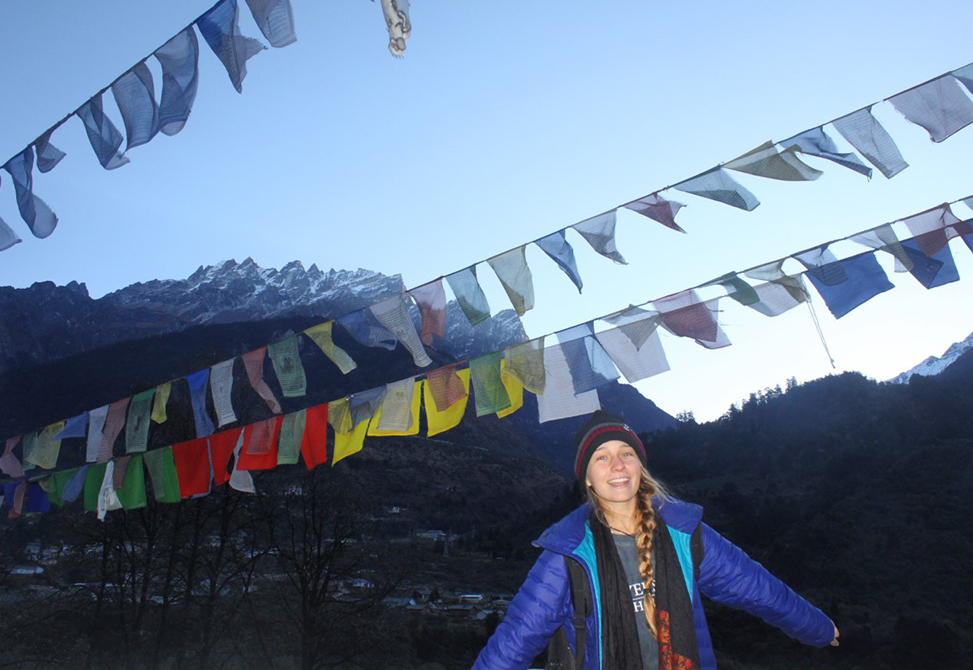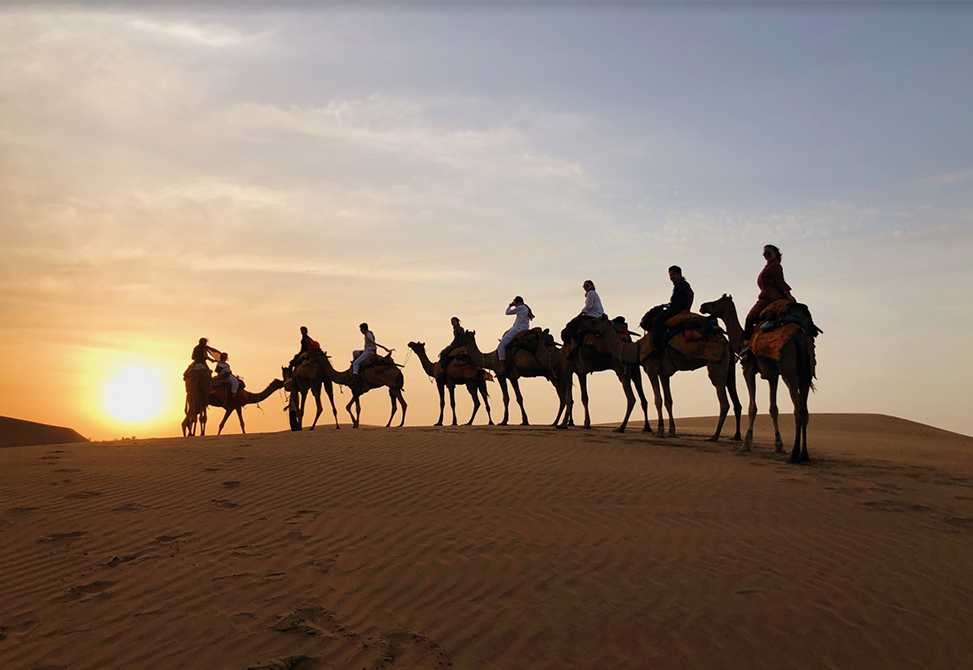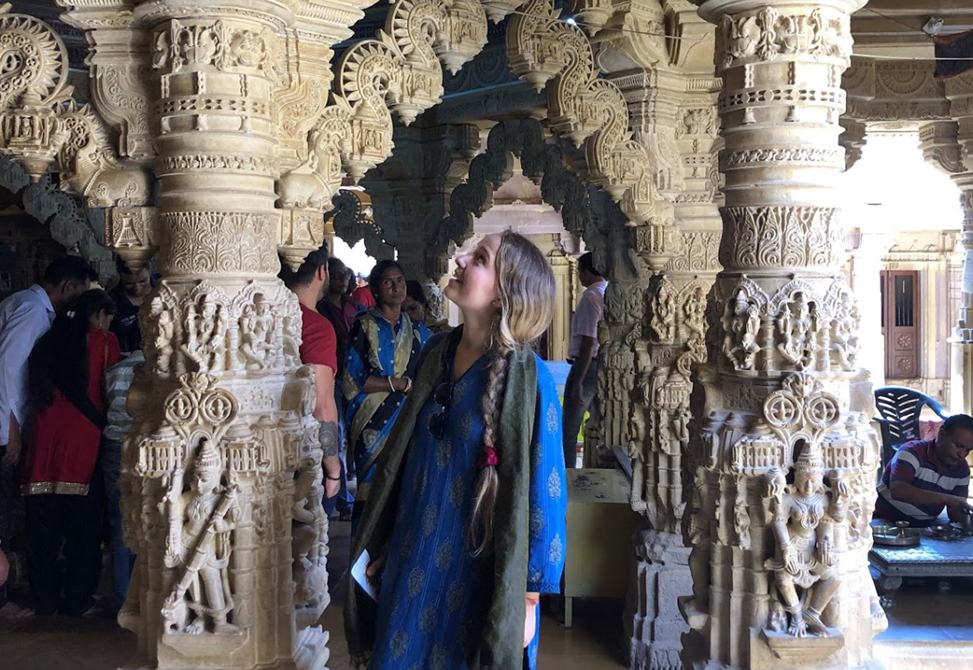Reflecting on India: Molly Cartwright (India '19)

Ambassador Molly Cartwright studied abroad on SIT’s semester-long program India: Sustainable Development & Social Change in 2019. A Global Studies and Interdisciplinary Studies double major from Florida, Molly is currently on a gap semester working for Colorado People’s Action, a nonprofit focused on racial, economic, and environmental justice. Molly recently shared reflections from the time she spent in India.


I can still taste the parathas oozing with cheese, the sweet daily chai, the brilliant, freshly picked pomegranate, the spicy dal clinging to my fingers. I can still hear the serene sound of flapping prayer flags, the icy Himalayan water flowing down the Testa, the euphoric sounds of the sitar, the screeching horns in the city, and the echoing call to prayer. I can still smell the aromatic incense smoke bellowing out of a temple, the burning smell of fireworks on Diwali. I can still see the white caps of the third largest mountain in the world from an entire state away, and the cows and camels trudging down the highways.
Most importantly, I can still feel India.
I can still feel the empathy pouring out of a refugee woman who explained that she forgives those who violently killed her family and forced her to flee her country. I can still feel the inspiring passion for environmental sustainability gushing out of the founder of the Save the Seed Movement. I can still feel the heavy resentment and disgust that enveloped me the night I walked out of a fancy restaurant and saw a group of people sleeping on the street. I can still feel the astonishment and respect I had for a man living in a Jaipur slum who could not read or write but casually learned to speak five languages through his daily encounters. I can still feel the love from my host mother as she insisted on treating me as a family member even as she struggles with the death of her mother. I can still feel the mighty empowerment bursting out of a fifteen-year-old girl who chose rejection by her entire village and family, and a life of financial struggle in a city on her own, in order to pursue a job instead of marriage.
India has impacted me beyond words, and I feel a deep desire to return and find a meaningful way to express my gratitude for all that I have been taught. It is this deep respect that has driven me to challenge the disturbingly pervasive negative stereotypes that have been used to define India by many Americans. Before I had even embarked on my journey, I had neighbors, family members, and strangers express confusion, questioning why I would want to study abroad in India. “Why would you want to go to such a dirty place with so much poverty?” This angered me before I even knew what a rich and rewarding place India would be. It astonished me that people only viewed India as a crowded, dirty place of poverty. I personally knew little about India at the time, but I still felt that these responses were such a simplified and disrespectful dismissal of an entire country. In her famous Ted Talk, titled “The Danger of a Single Story,” Nigerian author Chimamanda Adichie talks about the single story of Africa that we learn as Westerners, a story that has dehumanizing and dangerous impacts on people. Similarly, many Americans perceive India through a single narrative that revolves around poverty, dirt, and overpopulation. This single story originates from little to no real knowledge about India, as well as a lack of desire to learn.
During my time in India, I was constantly pondering the inequality of my world, as I became aware of the massive privileges I go through life without noticing. I realized rights that I assumed were basic and pervasive, such as the right to clean air, don’t exist for millions of children. I constantly felt waves of guilt and confusion about how I could achieve a fair and ethical lifestyle. However, a single story of India as a poor and desperate state is extremely
narrow-minded. It dismisses the country’s fancy restaurants and hotels, as well as the palaces and temples with spectacularly intricate designs and art. More importantly, this mindset also fails to acknowledge the disgusting inequality that is prevalent in the United States. Americans tend to picture the face of poverty as small brown children in faraway places, while completely ignoring the poverty in our own country. It is completely irrational to view poverty as a phenomenon unique to “developing” countries, and frankly, it is cruel to dismiss the suffering of millions of Americans facing poverty and food insecurity each year. We must be careful when pointing our fingers at the issues in other countries without critically acknowledging and examining the issues within our own.
I was reminded of this lesson while traveling to a rural village in Northern India to learn about the struggles faced by a historically nomadic tribal community as a result of India’s rapid development. I was so intrigued by these people’s way of life and the complex ways in which “development” conflicted with their daily lives, their ability to feed themselves, and the migration routes they travel with their herd animals. This seemed to be a unique issue that I had never encountered in the United States. However, my professor later drew a link between this village’s experiences and those of another group, much closer to home. He had visited a Native American reservation in the Midwest, where he saw rampant food insecurity, due to the development and violence that destroyed Natives’ traditional ways of living– a similar issue faced by the remote village in India. I began to realize that many of the issues I was encountering abroad were prevalent in the U.S., too. I may have chosen to travel in order to learn about sustainable development and social justice in an Indian context, but I often found myself using this new knowledge to examine my own country’s flaws. Poverty and injustice are pervasive throughout the world, and the United States is by no means an exception. We must not avoid confronting our own flaws by applying single stories of poverty onto other nations, in order to paint ourselves in a more positive light. If we are going to critique other nations, we need to be just as critical when examining our own country.
As I was returning home to Florida from Delhi, I was so excited to share my new knowledge of this incredible place and experience. However, when I returned to the United States, I once again encountered a baffling and belittling evaluation of my experience in India by other Americans. Rather than understanding how I could possibly see the land and people of India as a beautiful gift themselves, they assumed that India must have enlightened me on how much of a glorious gift the United States is. I can’t count the amount of times that people said “You must be so happy to be back in the United States,” or “It’s so good to go over there and see how they live. It makes you appreciate how great America is.” A single story of India not only dismisses the United States’ flaws, but it’s also used as an opportunity to glorify life in the United States.
Americans put this country on a global pedestal. We often hear that we live in “the greatest country on the planet.” Yet, we assume superiority without evaluating the consequences of this “greatness.” In my case, people thought American exceptionality came from the luxuries we enjoy, including luxurious homes with air condition and warm running water. However, the lifestyles of many Americans, which revolve around comfort and convenience, change value depending on one’s priorities: sustainability or consumption. If everyone lived like Americans, we would need five Earths to sustain life, versus the 0.6 Earths that would be needed if everyone lived like Indians. It would be utterly impossible for the entire world to sustain almost eight billion humans if they lived the lifestyle of Americans. To look down upon people who aren’t living the same destructive lives as ourselves reeks of ignorance. We need to question what we perceive to be “great” and consider the real consequences of our lifestyles before vilifying people with other ways of living.
You have to consciously avoid falling into single story narratives by actively learning from either native writers or people from these other countries. I personally fell into the single story narrative about gender in India. As a strong willed feminist, I was terrified of navigating a country that was “so sexist,” and I remember thinking I would have to actively tone down my feminism in order to be safe in India. There is no doubt that women should take many different precautions to be safe while navigating through India. Yet, there isn’t a country in the world in which women don’t have to consider violence and harassment based on their sex. Patriarchy is pervasive throughout the world, and sadly, violence against women accompanies that inequality. However, my study abroad experiences taught me that India is not a more sexist place than my own country; it’s a place where sexism just operates in a completely different way. I discovered that gender is complicated, and that women face different barriers and enjoy different progressions depending on their location on a map.
The discussion around what a woman should wear first showed me the complexity of gender. I had been taught I should wear what I want, and to fight against the sexualization of women’s bodies. However, my choice to wear long and loose pants and never show my shoulders actually drew the attention of a self-identifying feminist in the streets of the desert town of Jaisalmer. A confident middle-aged woman emerged from a store in one of the world’s last “living forts” and pulled me aside. She expressed her gratitude towards me for following her country’s customs and wearing modest clothing. She explained how she perceived tourists who wore revealing shorts and crop tops as having no respect for the country’s traditions. She later explained that she was a committed feminist who was disowned from her village and family at a young age because she refused to marry. She full-heartedly believed that women should explore life and find their own profession before marrying. That woman now spends her life teaching different trades to women in rural villages, so that they can achieve the freedoms of financial independence. I would never have guessed that the same woman who complimented me for wearing conservative clothing would be an unapologetic feminist. However, it’s important to understand that this woman’s views don’t represent the views of everyone in India’s women’s movement.
I met even more feminists who rejected “modest” clothing, and participated in “Slut Walks,” which is a movement that rejects shaming and guilting sexual assault victims for their appearances. I grew close to women who chose to never marry, a stigmatized choice which can be debilitating in Indian society. I spoke to financially independent teenagers who were disowned by their families because of their aspirations for autonomy. In the U.S., it’s far easier for women to avoid marriage and enjoy professional life. Women also have more freedom in clothing choice here. However, the U.S. has yet to be graced by a women president, while India achieved a female prime minister around sixty years ago. Many women in India also possess traditional and indigenous knowledge that gives them extraordinary power in farming and other areas of life. I don’t bring up these stories and comparisons to promote one country over another;
I just want to hammer home that the single story I had heard of gender in India does not constitute the full, complex picture. Different women have different ideas of what liberation and equality look like.
I want to share one last experience that shows just how dangerous and blinding a single story can be. While sitting in a Florida coffee shop, I ended up discussing my experience in India with the owner. He asked, “Do Indians value human life a lot less than us?” I was quite confused until he went on to explain that he had seen a video of someone getting run over by a car in India. In the video, no one rushed to help the injured person. I didn’t hold back. I told him how insulting this perspective was. I tried emphasizing that plenty of Americans would do the exact same thing. He immediately provided what he thought was a reasonable defense by saying, “Oh no, it isn’t about if they are bad or good. They just value life so much less because there are so many more people.” This man’s perception of Indians is by far the most appalling and shameful response I have ever heard. He saw one upsetting video taken there, and felt that it made sense to dehumanize around seventeen percent of the world’s population based on a four minute clip. Dehumanizing entire countries becomes possible when we unapologetically and uncritically accept single narratives of other places. With a disturbing amount of xenophobia and discrimination occurring in this country, I believe one step towards mending the hate in people’s hearts is attempting to learn about the people and places we don’t understand. If we listen and try to learn, I believe empathy can replace discrimination based on misunderstanding.
A single story of India erases the kindness flowing from the man who invited me to his nephew’s wedding after I spilled pasta sauce all over him on an overnight train. A single story erases the devotion of a Sadhu living alongside the Ganga who gave up every aspect of lay life for his religion. It erases the diversity of rich, flavorful, and mouthwatering spices and dishes devoured in this country. It erases the pure joy a father feels while playing cricket with his son. It erases the spirit of Diwali I witnessed when a woman passed out popsicles to children and strangers in neighboring cars during a red light. It erases some of the most critical biodiversity hotspots in the world. It erases the serious love that my professors have for their daily cup of chai. It erases the generational wisdom in traditional farming women selecting seeds to save for the next season in the world’s first organic state. It erases an indigenous activist’s sacrifices and years in prison for uprooting a dam project that would have destroyed a river system that is sacred to his people. It erases the deep dedication a mother living in a slum has to sending her children to school, in order for them to escape the life of poverty she has struggled through. It erases one of the world’s most peaceful liberation movements, and the deep struggle and courageous resistance Indians participated in to end the despicable colonialism ruling their lives.
A single story of India ignores it all, the whole beautiful tapestry of diversity and humanity, the most impactful place I have ever been.

